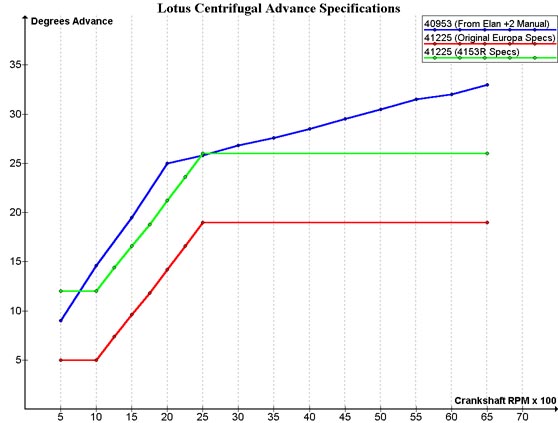|
YL 2558101 |
The standard internals of the Mallory Dual Point |
A New Spin on Ignition
(Or installing a Mallory distributor in a Twin Cam engine)
Part 1 - Getting all the parts together
While the original Lucas 25D4 distributor, fitted to late Twin Cam engines, is perfectly adequate for a street-driven engine, upgrades can be made for both better reliability and improved performance. The 25D4 is not terribly unreliable or restrictive to the power output of a Twin Cam when new, but 30+ years and countless miles (along with likely abuse and/or neglect) means that the distributor in a Twin Cam may or may not be performing at its best. Common problems with original 25D4 distributors include worn bushings, broken distributor bodies, worn out or broken advance mechanisms, and tinkering done by someone who had no clue what they were doing. The distributor in my car suffers from a yet-to-be-explained accelerated wearing of the points rubbing block. It is possible to find replacement distributors, even in unused condition, but the cost on complete units can be shocking. Many replacement parts are still available, but some problems are difficult or impossible to fix without replacing the entire distributor. Also, there is much better ignition technology available today that was only experimental or not possible to mass produce when the Twin Cam engine was produced; the 25D4 distributor can be modified to work with capacitive discharge ignitions as well as magnetic and optical triggers to replace the points, but optimizing the advance curve can be a shot in the dark, or just a royal pain if you have access to a distributor curve machine and can find the needed parts.
This brings me to the Mallory distributor. While this distributor alone will never solve the problems of the Lucas 25D4, it allows a greater range of tuning options for the ignition system in a more robust package. The body of the Mallory is machined aluminum, versus the cast aluminum body of the Lucas units, while the internal parts of the Mallory are of noticeably better quality. The Mallory allows maximum advance to be set by the user, and a spring kit allows a wide variety of advance curves to be used - much better than modifying (or trying to find) weights and springs to fit the Lucas unit. Installing a Mallory distributor sounds like a great idea, right? I think so, and I will be detailing the installation of a Mallory distributor in Europa 4153R.
|
YL 2558101 |
The standard internals of the Mallory Dual Point |
The Mallory unit that I have acquired is part # 2558101, originally made to fit a Ford Pinto. It is a dual-point, mechanical advance unit, and is the smaller of the two distributors that Mallory produces for the Pinto application. Instead of using the dual points (no advantage in a street engine, and a step back as far as maintenance goes) I will be installing a magnetic trigger from Pertronix. Higher voltage is a good thing, and a high-power coil will be fitted in place of the Lucas Sport coil. The advance curve will be changed to something similar to the European-spec Stromberg Twin Cam distributor (40953) using Mallory's advance curve spring kit. Because of the increased voltage, thicker plug wires will be fitted from Magnecor. Also, the standard distributor clamp plate will not work the the Mallory - but a Pinto/Ford 1600 clamp solves that problem. Here is a break-down of the parts I will be using (or choosing from if there is more than one part listed):
| Distrbutor | Mallory Dual Point YL 2558101 "Ford Pinto" application |
| Advance curve kit | Mallory 29015 YL Recurve Kit |
| Distributor Clamp | Ford Pinto 480M6896 |
| Sparkplug Wires | Magnecor 40204 (8mm - other sizes available) |
| Points Replacement | Pertronix Ignitor ML-141
Pertronix Ignitor II 9ML-141 |
| High-Voltage coil | MSD Blaster (45,000V)
Pertronix Flame Thrower (40,000V) Others |
As you can see in the graph below, the factory specifications for the Europa distributor (41225) are much different than the non-emissions engine (40953). I have also included the current advance curve on 4153R, which is the original 41225 set at 12-13° static advance versus the original 5°. While setting the static advance higher gets you closer to the 40953 curve, the advance still tops out at 2500 RPM.

It is important to note that installing the Mallory will not necessarily increase horsepower or torque; what it does do, however, is allow you to maximize your ignition and get you closer to realizing the full potential of the Twin Cam engine in its particular state of build and tune. The original Europa TC distributor (41225) has a much different advance curve than the European-spec Stromberg-carbed Twin Cams fitted to Elans, Elan +2's (40953). This is because of the attempt by Lotus to make the Twin Cam meet federal emissions standards for the early 1970's. Back-dating to something closer to Lotus's original intentions should allow the engine to produce a bit more power and give better driving characteristics. Obviously, the rest of the systems (carbs, exhaust, etc.) must be in good order for an ignition upgrade to make much difference, and the original restrictive emissions equipment must also be removed. Please realize that this is not exactly legal, and more than likely will cause your Europa to fail emissions testing and/or vehicle inspection if either are required.
Look for part 2 sometime in the future - at the moment I can't say when the next issue will be published, however!
References: Lotus Twin Cam Engine by Miles Wilkins', An Examination of Twin Cam Distributors by Dave Comeau (Lotus Ltd. article), and Installing a Mallory Ignition in a Europa by Ron Dawson (Lotus Ltd. article)
©2004 Aaron Hines